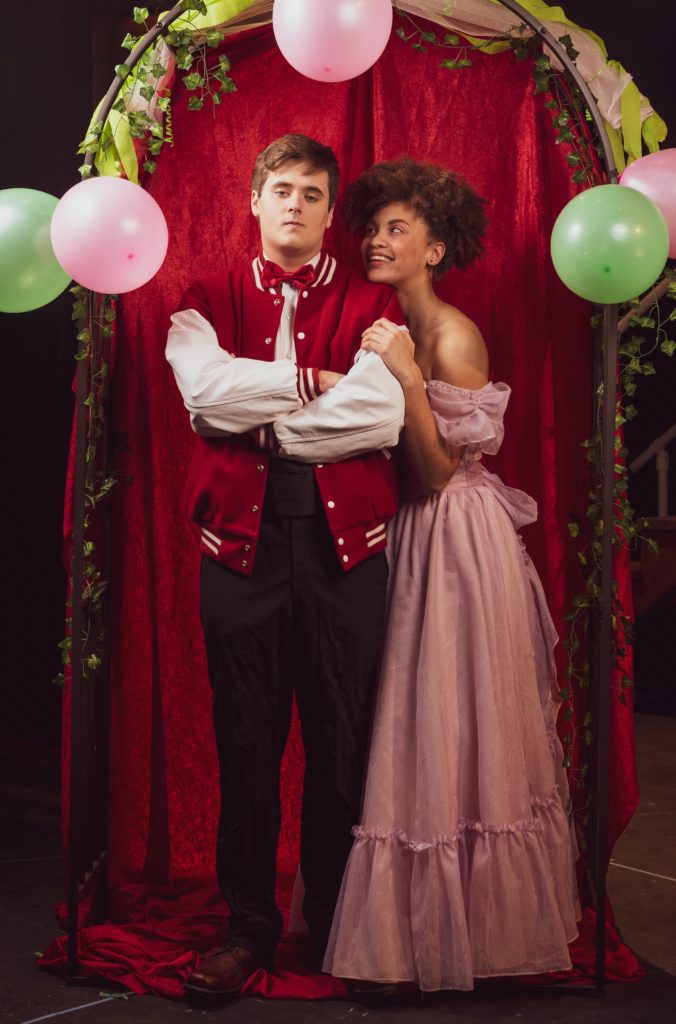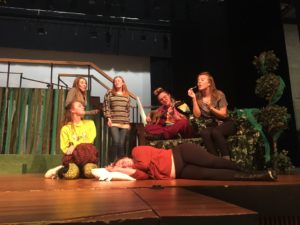
A vision in satin, Helena (Abigail Walker) poses at prom beside her beau, Demetrius (Casey Hennessy).
The ’80s: from the photos I’ve seen of my parents during that time, it involved a lot of blue eyeshadow, shoulder pads, teased hair styled to stiffness with hairspray and monstrously large satin prom dresses.
My John Hughes-inspired fantasy of the era rarely involves Shakespeare.
Every other year, Theatre NDSU performs one of William Shakespeare’s iconic plays as part of their regular season. For the Shakespeare slot this year, “A Midsummer Night’s Dream” was selected.
Immediately, director Jess Jung thought of ways to make the story, something she’s seen many times before, new and interesting to the audience.
“I personally love Helena’s journey in the play,” Jung said. “I think it’s important and fun, and I think any person who was ever a teenage girl relates to what Helena is going through. And I just had an image of Molly Ringwald in ‘Sixteen Candles,’ which happens to be one of my favorite movies.”
From this connection came Jung’s inspiration going forward into the show: infusing ’80s elements throughout a theater classic.
Jung started with the characters of the play. She identified their personalities and their wants and needs throughout the work.
“And then I thought, ‘Well, who are they in these movies?’” Jung explained. “Demetrius was very much the meathead jock in ‘Breakfast Club.’ Helena is absolutely Molly Ringwald in ‘Sixteen Candles.’ Lysander and Hermia are ‘Say Anything’ … to me, that kind of perfect couple.”
Of course, within “A Midsummer Night’s Dream,” there are two distinct worlds: that of the lovers and that of the fairies. While Jung used ’80s movies as the basis for the lovers, she used other ’80s icons for the world of the fairies: rock stars.
“Oberon is modeled after the classic ’80s hair rocker,” she explained. “Bon Jovi meets Joan Jett. Titania is Cindy Lauper/Madonna/Whitney Houston, all rolled up in one.”
She continued, “The forest then became a music world that the high schoolers get sucked up into.”
Alongside the characters, the set and the costumes reflect the era, using plenty of colors and proving the point that bigger is better.
“The costumes are off the hook,” Jung said. “It’s totally ridiculous. Literally, every time at the end of rehearsal, I’m like, ‘What am I directing? Who had this idea?’”
The costumers have had their hands full, interpreting Jung’s vision of an ’80s prom into costumes that meet the bombastic-ness the ’80s is known for.
“I think it’s difficult to do a concept,” Jung said. “It’s just different. To have to explain a vision of a show and put a frame on a show that’s not there. From the design process, I had to describe what I saw visually.”
The costumers did extensive research into the ’80s before creating their designs.
Raffi Ferreira, a BFA student specializing in theater makeup and costume design, is creating the prom outfits for the lovers and the fairies. He explained that one challenge of the process was “trying to figure out what was true ’80s versus what we think of as ’80s.”
To do research, Ferreira looked at visuals in books, magazines and catalogues, watched music videos and even borrowed photos from his aunts and uncles who went to prom in the ’80s.
Ferreira said one dress in particular was the most fun to design and create: a gold number created for the character of Hippolyta.
“The biggest one of all is Hippolyta, with this ginormous gold dress that’s just huge and very asymmetrical like how a lot of ’80s dresses were,” he said. “Those were the most fun.”
While for most of us, this alone sounds outrageous enough, as the play progresses the costumes only get more and more fantastic. For example, Jung points out that Oberon, the King of the Fairies, wears a leather jacket with arm-to-arm, floor-length fringe.
Ariel Walker, who plays Oberon in the show, explains the jacket provides a lot to her character, but also adds an extra challenge.

When the characters in ‘A Midsummer Night’s Dream’ are transported into the world of the fairies, they’re also transported into a crazier version of MTV in the ’80s (complete with familiar rock stars).
“Part of it’s hard because no matter what, when I move, even if it’s just the littlest amount, the fringe will just move everywhere,” she explained. “And I’ll take focus. So, it’s really hard sometimes to just stay still whenever I need to not be the one in focus.”
The costumes, despite being gaudy and crazy and largely impractical, are adding a lot to the stage visually and through the characters.
“For the majority of the show, I wear these bright red cowboy boots that are really heavy,” Walker said. “Whenever I’m walking around, even if I’m trying to walk really quietly, it’s super loud. Something about it makes me feel super powerful. The slower I walk — which Oberon has to do, because he’s so cool and whatnot — the slower I walk in those shoes, I just feel so great. It really makes me get into character like that.”
Not only are the actors adjusting their costumes to the stage, but so too are the costume designers.
Ashly Tryon is a theater student with a focus on technical and costumes. She has been designing the dream world of “A Midsummer Night’s Dream,” focusing on the fairies-turned-rock-stars.
Much of her inspiration has come from ’80s music videos, Prince in particular. But, she explains, one of the hardest aspects of adapting Prince to the play has been the movement involved in the production.
“You take Prince, for example. The way his jacket is,” she said. “It would be fine if you were standing in one spot and playing the guitar and singing. But our actors are moving around so much that it has to be something that they can also move and be comfortable in.”
But most students are loving the creativity in the costumes.
“The prom dress: I would wear it every day if I could,” Shanya Hawari, a freshman who plays one of the Mechanicals, said. “It’s so cute.”
Megan Frisk, a sophomore in the theater arts program who plays Hermia in “A Midsummer Night’s Dream,” even got bangs for the occasion.
“I honestly, I’ve kind of been waiting,” Frisk said, in response to getting her bangs cut. “Because we do the audition form, and it’s like, ‘Are you willing to change your hair?’ I’ve been waiting for someone to be like, hey, I want you to do this drastic thing with your hair. Because, then, if you hate it, you can be like, I had to for the show. But also, it makes me step outside of my box.”
Theatre NDSU’s “A Midsummer Night’s Dream” opens Thursday, Nov. 29, at 7:30 p.m. in Askanase Auditorium. Performances run through Dec. 8. Tickets are free for NDSU students and can be purchased through the NDSU Performing Arts Box Office or online.
